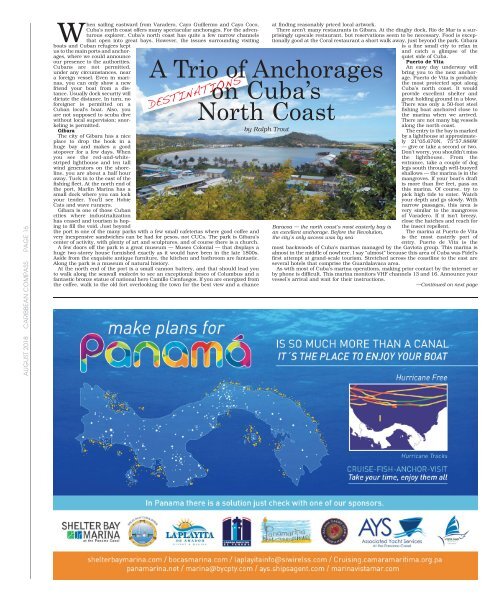Caribbean Compass Yachting Magazine - August 2018
Welcome to Caribbean Compass, the most widely-read boating publication in the Caribbean! THE MOST NEWS YOU CAN USE - feature articles on cruising destinations, regattas, environment, events...
Welcome to Caribbean Compass, the most widely-read boating publication in the Caribbean! THE MOST NEWS YOU CAN USE - feature articles on cruising destinations, regattas, environment, events...
You also want an ePaper? Increase the reach of your titles
YUMPU automatically turns print PDFs into web optimized ePapers that Google loves.
AUGUST <strong>2018</strong> CARIBBEAN COMPASS PAGE 16<br />
When sailing eastward from Varadero, Cayo Guillermo and Cayo Coco,<br />
Cuba’s north coast offers many spectacular anchorages. For the adventurous<br />
explorer, Cuba’s north coast has quite a few narrow channels<br />
that open into great bays. However, the issues surrounding visiting<br />
boats and Cuban refugees kept<br />
us to the main ports and anchorages,<br />
where we could announce<br />
our presence to the authorities.<br />
Cubans are not permitted,<br />
under any circumstances, near<br />
a foreign vessel. Even in marinas,<br />
you can only show a new<br />
friend your boat from a distance.<br />
Usually dock security will<br />
dictate the distance. In turn, no<br />
foreigner is permitted on a<br />
Cuban local’s boat. Also, you<br />
are not supposed to scuba dive<br />
without local supervision; snorkeling<br />
is permitted.<br />
Gibara<br />
The city of Gibara has a nice<br />
place to drop the hook in a<br />
huge bay and makes a good<br />
stopover for a few days. When<br />
you see the red-and-whitestriped<br />
lighthouse and ten tall<br />
wind generators on the shoreline,<br />
you are about a half hour<br />
away. Tuck in to the east of the<br />
fishing fleet. At the north end of<br />
the port, Marlin Marina has a<br />
small dock where you can lock<br />
your tender. You’ll see Hobie<br />
Cats and wave runners.<br />
Gibara is one of those Cuban<br />
cities where industrialization<br />
has ceased and tourism is hoping<br />
to fill the void. Just beyond<br />
DESTINATIONS<br />
the port is one of the many parks with a few small cafeterias where good coffee and<br />
very inexpensive sandwiches can be had for pesos, not CUCs. The park is Gibara’s<br />
center of activity, with plenty of art and sculptures, and of course there is a church.<br />
A few doors off the park is a great museum — Museo Colonial — that displays a<br />
huge two-storey house furnished exactly as it would have been in the late 1800s.<br />
Aside from the exquisite antique furniture, the kitchen and bathroom are fantastic.<br />
Along the park is a museum of natural history.<br />
At the north end of the port is a small cannon battery, and that should lead you<br />
to walk along the seawall malecón to see an exceptional fresco of Columbus and a<br />
fantastic bronze statue of national hero Camillo Cienfuegos. If you are energized from<br />
the coffee, walk to the old fort overlooking the town for the best view and a chance<br />
at finding reasonably priced local artwork.<br />
There aren’t many restaurants in Gibara. At the dinghy dock, Rio de Mar is a surprisingly<br />
upscale restaurant, but reservations seem to be necessary. Food is exceptionally<br />
good at the Coral restaurant a short walk away, just beyond the park. Gibara<br />
is a fine small city to relax in<br />
and catch a glimpse of the<br />
quiet side of Cuba.<br />
Puerto de Vita<br />
An easy day underway will<br />
A Trio of Anchorages<br />
on Cuba’s<br />
North Coast<br />
by Ralph Trout<br />
Baracoa — the north coast’s most easterly bay is<br />
an excellent anchorage. Before the Revolution,<br />
the city’s only access was by sea<br />
bring you to the next anchorage.<br />
Puerto de Vita is probably<br />
the most protected spot along<br />
Cuba’s north coast. It would<br />
provide excellent shelter and<br />
great holding ground in a blow.<br />
There was only a 50-foot steel<br />
fishing boat anchored close to<br />
the marina when we arrived.<br />
There are not many big vessels<br />
along the north coast.<br />
The entry to the bay is marked<br />
by a lighthouse at approximately<br />
21°05.670N, 75°57.886W<br />
— give or take a second or two.<br />
Don’t worry, you shouldn’t miss<br />
the lighthouse. From the<br />
entrance, take a couple of dog<br />
legs south through well-buoyed<br />
shallows — the marina is in the<br />
mangroves. If your boat’s draft<br />
is more than five feet, pass on<br />
this marina. Of course, try to<br />
pick high tide to enter. Watch<br />
your depth and go slowly. With<br />
narrow passages, this area is<br />
very similar to the mangroves<br />
of Varadero. If it isn’t breezy,<br />
close the hatches and reach for<br />
the insect repellent.<br />
The marina at Puerto de Vita<br />
is the most easterly port of<br />
entry. Puerto de Vita is the<br />
most backwoods of Cuba’s marinas managed by the Gaviota group. This marina is<br />
almost in the middle of nowhere. I say “almost” because this area of Cuba was Fidel’s<br />
first attempt at grand-scale tourism. Stretched across the coastline to the east are<br />
several hotels that comprise the Guardalavaca area.<br />
As with most of Cuba’s marina operations, making prior contact by the internet or<br />
by phone is difficult. This marina monitors VHF channels 13 and 16. Announce your<br />
vessel’s arrival and wait for their instructions.<br />
—Continued on next page


















